People
Ceramicists Michael and Magdalena Frimkess Defined Venice Beach’s Bohemia—Now Their Granddaughter Is Taking Up the Mantle
Emerging artist Sachi Moskowitz recently opened her solo exhibition "Dorsal View" at Half Gallery's Annex in New York.
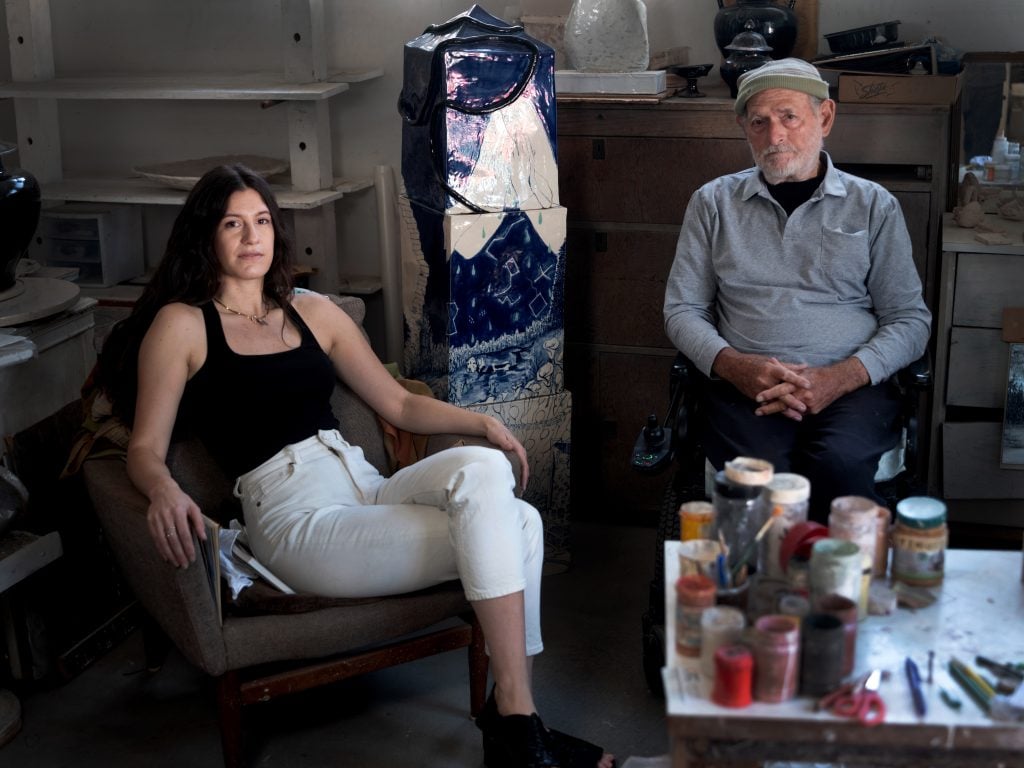
Sachi Moskowitz walks through her grandparents’ Venice ceramics studio keeping an eye out for potential damage following a major Southern California rainstorm in February. A large plastic vat situated beneath a known pesky spot in the ceiling has filled with water. Taylor Williams, an art handler who happens to be dropping by that day, delicately wrangles the heavy container onto a dolly and relocated the vessel near the alley behind the series of rooms that are packed with equipment and projects in various stages.
Moskowitz knows better than to entirely dispose of its contents. “Papa, there’s a lot of clay in there. What should we do with it?” she asks. “I don’t think it’s clay. It’s glaze. I’m going to remove it and put it in the scrap glaze,” Michael Frimkess responds. “I learned from my teacher Peter Voulkos you always keep the scrap glaze so that you don’t waste anything,” he recalls of Voulkos, the seminal West Coast ceramic artist who altered his path. Frimkess’s next directive is clear. “Pour the water out and I’ll be able to dig the glaze out,” he calls out in a firm yet raspy voice while surveying the scene from his motorized wheelchair.
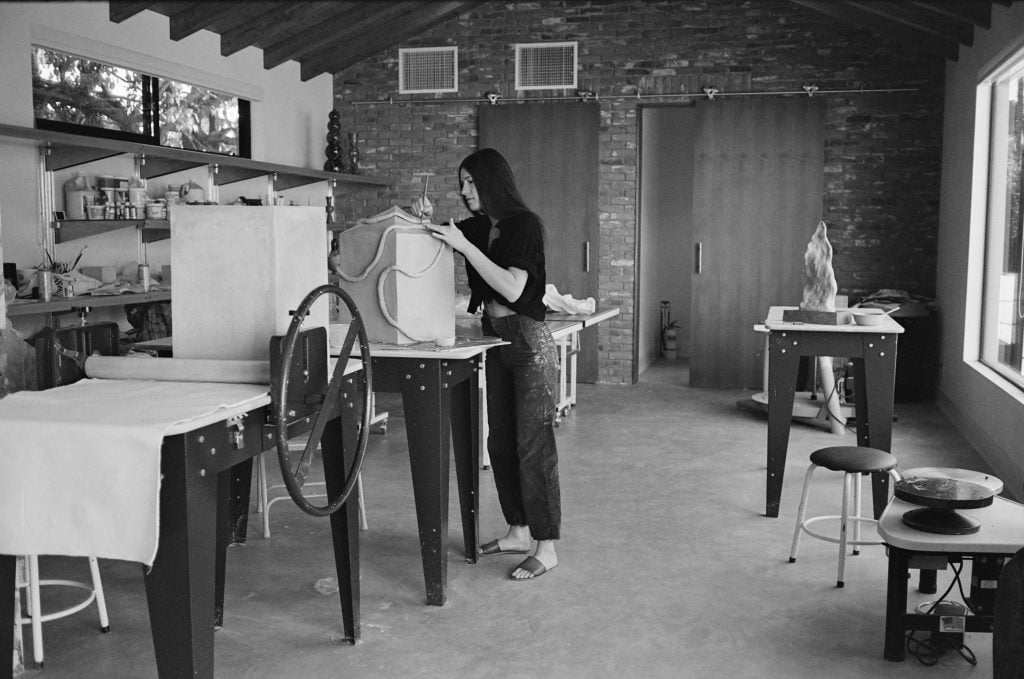
Sachi Moskowitz in her Los Angeles studio. Photo by Lance Shigematsu.
As far as the dynamic between conscientious grandchild and doting grandparents is concerned, the ways in which Moskowitz relates to her maternal grandparents, artists Michael and Magdalena Suarez Frimkess, is singular. She’s both eager student and caretaker, as well as a steward of a family legacy that has attracted more attention in recent years. The couple, who feel like the last of the true Venice bohemians, were long under-the-radar artists to certain corners of the art world despite their ties to the California Clay Movement.
This is a family of busy makers, whether at age 94 (Magdalena), 87 (Michael), or 34 (Moskowitz). The past decade’s groundswell of admiration has generally grown in tandem with the increasing number of prescription medication bottles on the Frimkess family’s well-worn wood and tile kitchen table. Receiving recognition in the Hammer Museum’s Made in L.A. 2014 biennial brought fresh interest in their work.
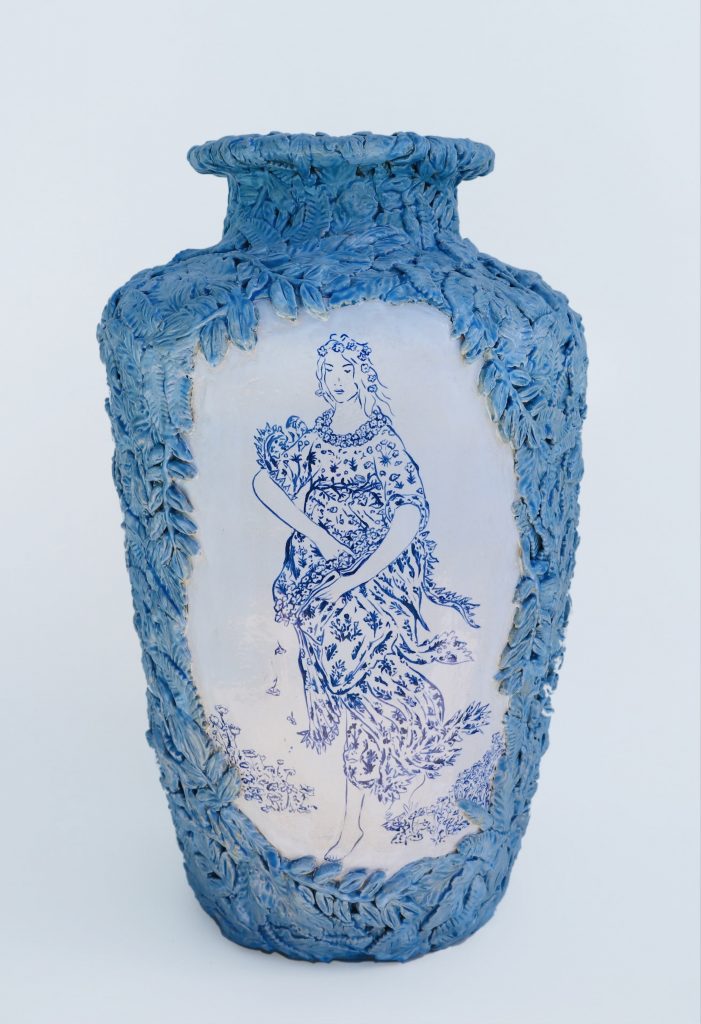
Sachi Moskowitz, Flora (2024), which is featured in Moskowitz’s solo show “Dorsal View” at Half Gallery Annex, New York City.
Michael and Magdalena’s handmade pieces embellished with pop cultural, ancient, and personal imagery that skip across and unite centuries began fetching higher prices at auction, in galleries, and other nontraditional spaces. Mark Grotjahn and Jonas Wood are counted among their most avid collectors and fans. While Magdalena is represented by Kaufmann Repetto, Magdalena and Michael’s works, exhibitions, and representation are presented elsewhere as joint and individual. A selection of Michael’s early works on paper and in clay opens at Barbati Gallery in Venice this summer and will be followed by a presentation from Moskowitz. “Dorsal View”, which marks Moskowitz’s first New York City solo show, opened on March 22 at Half Gallery Annex next to work by Geoff McFetridge presented in the main gallery space. Anna Erickson Presents will host a solo booth featuring Moskowitz at the Untitled Art Fair in Miami this December.
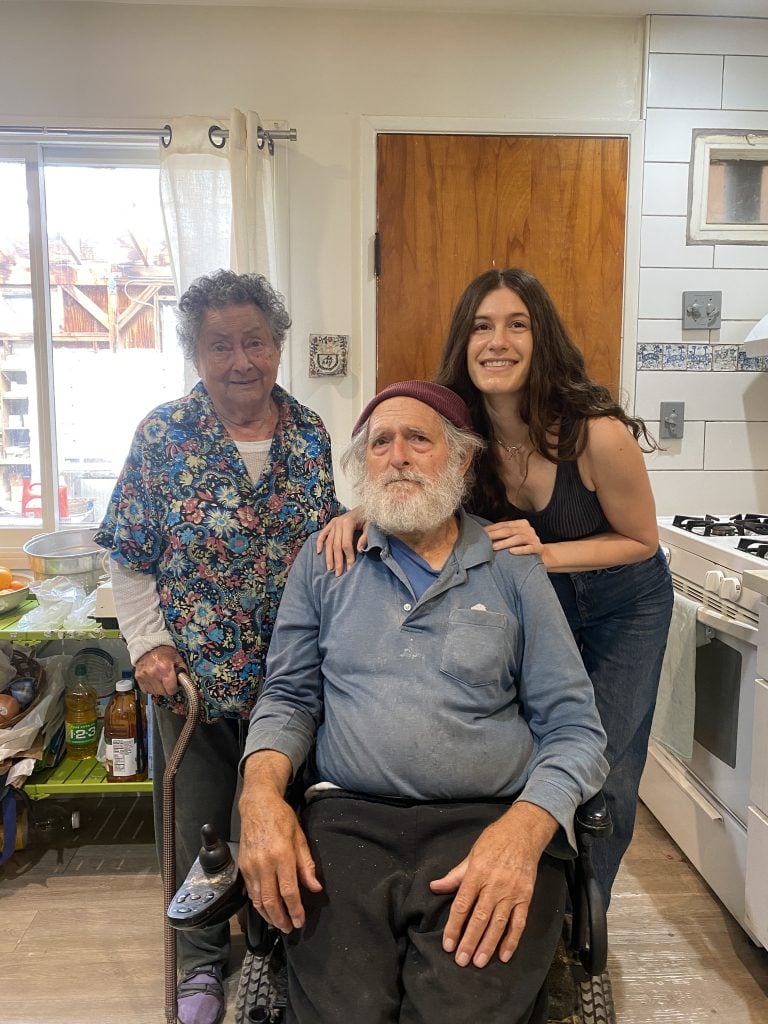
Magdalena and Michael Frimkess with their granddaughter, Sachi Moskowitz, 2024
During a weekday visit to the Frimkess’s home and studio, Magdalena is warmly hospitable and cordial, even if she’s already juggling multiple phone calls and unavailable to participate in conversation. In contrast, Michael shows zero hesitancy to dive into various chapters of his past, starting from his left-wing, atheist Jewish upbringing in the multiethnic, post-white flight community of 1940s Boyle Heights where compelling relatives (such as his McCarthy-era blacklisted uncle, Joseph Hittleman) and vivid characters shaped his worldview that defaults to siding with marginalized groups; to how his multiple sclerosis diagnosis in the early 1970s drastically changed his artistic practice and collaborations with Magdalena, who has always avoided the wheel and paints and glazes daily, revisiting familiar figures and tropes, such as Disney icons and Condorito, a comic strip character from Chile. Magdalena’s own steady, quiet determination has proved inspiring to a younger generation of female ceramic artists.
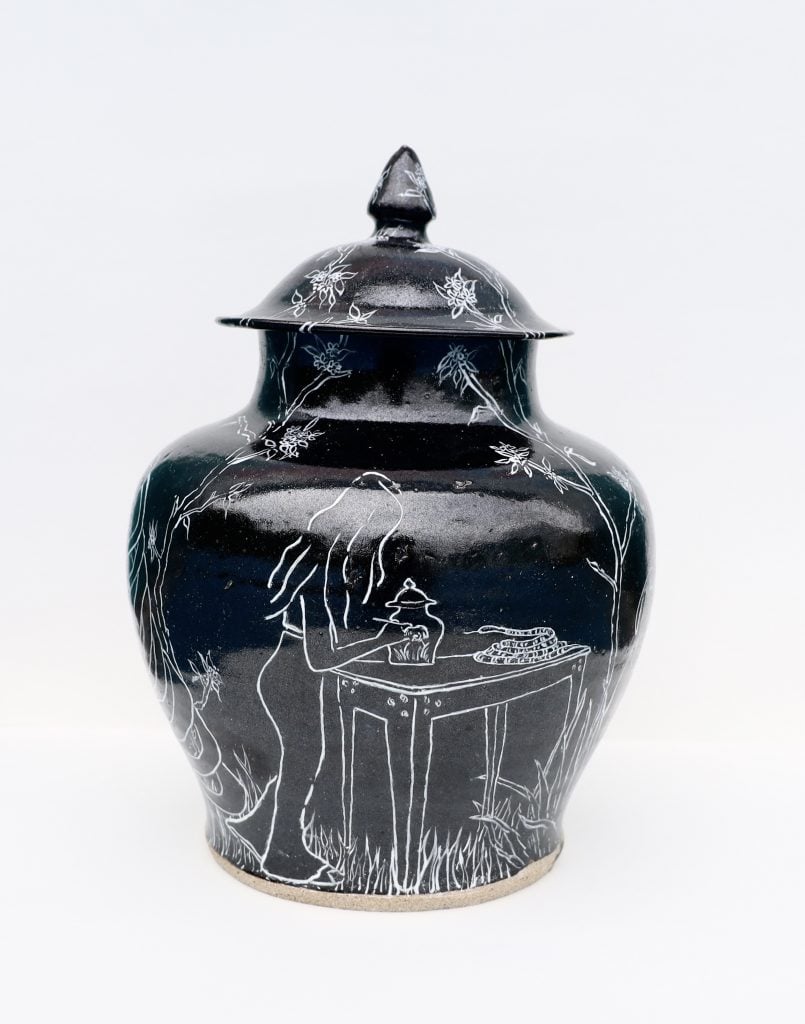
Out Getting Ribs a collaborative project, with china painted by Sachi Moskowitz in 2024 on stoneware thrown by Michael in 1976.
A former musician and lifelong jazz fanatic whose revelation during a peyote trip pivoted his focus to the medium of ceramics, music remains at the core of his identity. (His well-worn triptych shrine to Charlie Parker still stands on a table with plastic-covered raw clay figurines by Michael, along with miscellaneous remnants.) To Frimkess, these pursuits are linked and have a spiritual power. “When you throw with the thin [clay], it picks up the vibrations of the machine—the potter’s wheel—and then hums as you throw. It makes music,” he says about the ancient Greek dry clay throwing method he mastered, for which he designed specialized tools and techniques.
Michael Frimkess long clashed with some of the more traditionalist values and leading figures of the ceramics establishment before gaining acceptance into the broader conversation and institutions. And yet his complicated outsider status is still palpable. When pointing out his perennially in-progress double-chamber, high-powered kiln, for instance, he says “They won’t listen to me.” Art schools would have been “much better off” had they adopted his ingenuity, he insists. “The whole field was reactionary—no Commies there. They were against me.”
Michael and Magdalena’s meeting in 1963 set the stage for an unorthodox life. The pair met when they overlapped in Port Chester, New York, a result of Michael having followed Voulkos to the Clay Art Center. Venezuela-raised Magdalena—who was married with two children—had a scholarship to go abroad while she was studying at the Catholic University of Chile. Michael too had already lived a few lives, bouncing in and out of the then-named Otis Art Institute where he studied under Voulkos with peers including Billy Al Bengston and Ken Price. Learning production skills at a ceramics factory in southern Italy added a different and practical dimension to his professional and creative journey.
The couple’s move to L.A. after their tumultuous New York stint (which included Michael’s teaching at Pratt Institute during which he admittedly ‘was more interested in working out what was going on with my saxophone’) allowed Michael to be nearer to his parents, with whom he was close. In addition to Magdalena’s two children and Michael’s daughter, Leila, from a previous marriage (Leila is Moskowitz’s mother), Magdelena and Michael welcomed a daughter, Luisa, born in 1965.
The Frimkess creative streak is at least three generations deep. Michael’s father, Lou Frimkess, was a notable graphic designer who moved the family a few miles west from East L.A. to a modernist house in the Hollywood Hills designed by architect Kemper Nomland when Michael was a teenager. He was relentlessly supportive of his son’s continually progressing yet challenging career, helping him secure a studio in a former 1920s auto garage on what was then West Washington Boulevard (now it’s the Butcher’s Daughter restaurant on Abbot Kinney) where they produced for almost 10 years.
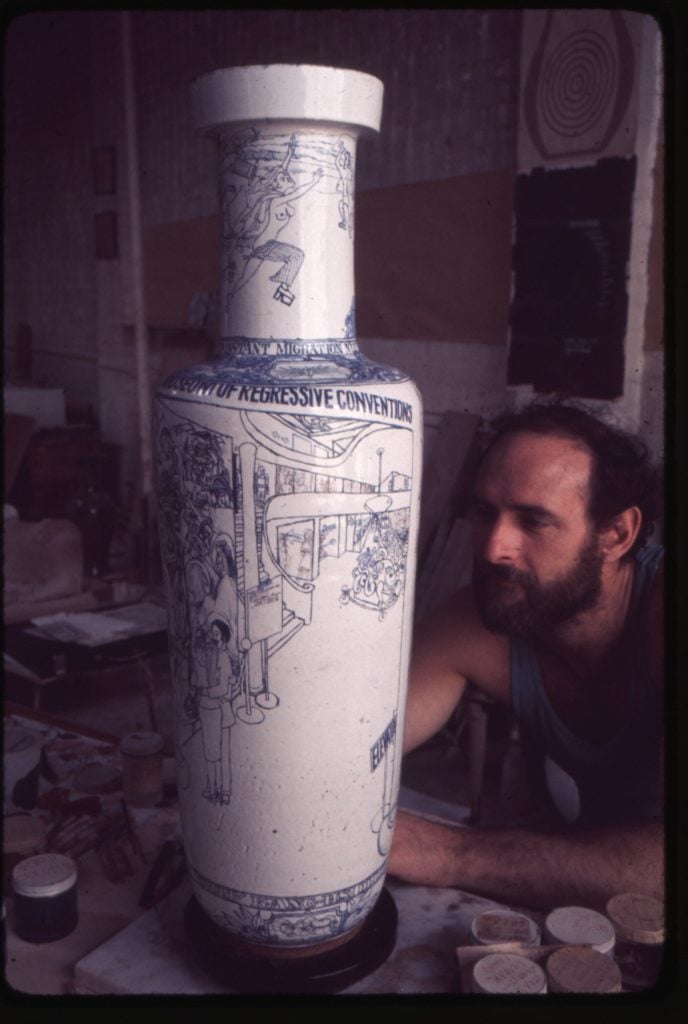
Michael Frimkess at work photographed by his father, Lou Frimkess, unspecified date.
“It was a cavernous brick building with excellent acoustics, and all the musician friends when they visited me the first time [would say], ‘Oh my god,'” Frimkess explains. “We had a lot of concerts.” Leila Frimkess married painter Stewart Moskowitz, who passed away in 2017, in the space. Michael’s friend, noted bass player Buell Neidlinger, assembled an epic band for the occasion. When Michael’s diagnosis with multiple sclerosis called for six hours of daily physical therapy—the family was prompted to move from an apartment in Echo Park to the modest Venice century-plus-old bungalow with an empty lot a stone’s throw from the West Washington site that would eventually house the adjacent studio long before the arrival of real estate speculators and tech titans.
Non-linear trajectories are somewhat of a family tradition. Moskowitz was raised in Topanga Canyon until her parents and three siblings moved to Humboldt when she was a teenager. Graduating high school early, returning to L.A., and living with her then-94-year-old great-grandmother Celia Frimkess brought her closer to Michael and Magdalena, even if it took longer to solidify her relationship with ceramics. She completed a BFA at San Francisco Art Institute with a concentration in painting in 2017, but it wasn’t until she signed up for a ceramics class at Santa Monica College with professor Franklyn Phillips that things clicked.
“I think this is it,” she remembers feeling. “I love drawing on paper, so I was able to do that on ceramics. It felt so meant to be.” Moskowitz made “shitty vessels” but gravitated towards wall-hanging ceramics, a form she still employs. Vases and vessels with classical proportions, a key component of the Frimkess family vernacular, are now part of her practice, which she coil builds.
She also completes pieces her grandfather crafted decades earlier such as “Out Getting Ribs,” a stoneware pot Michael threw in 1976 upon which Moskowitz China painted intimate vignettes. In the past couple of years she’s exhibited work in group shows at galleries including One Trick Pony, Over the Influence, Charlie James Gallery, and Sebastian Gladstone. “Times Imprint,” an installation with Sandrine Abessera, was on view this winter at house gallery Maison Lune in Venice.
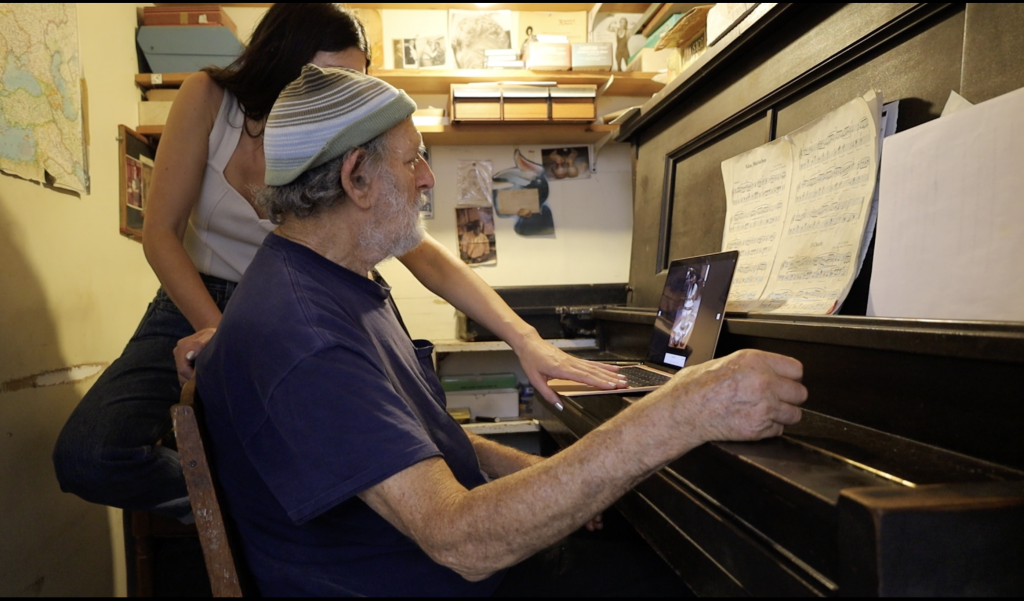
Michael Frimkess and Sachi Moskowitz at Michael’s piano in his music room within Magdalena Suarez Frimkess’s home and studio in Venice. Courtesy of Sachi Moskowitz.
For Moskowitz, family pressure manifests in specific ways. “I was disappointed she didn’t become a vortex specialist so I can give somebody all the tools I developed,” Michael Frimkess says. To which Moskowitz, who like Magdalena “is not a thrower” despite making intentions to learn the skill responds, “It’s hard not to compare myself.”
“You don’t have to think like that at all,” her grandfather says, recounting how one of his proteges surpassed his own level of knowledge, in part because of limits imposed by MS. But this critique isn’t an insurmountable hurdle. There’s too much else to bond over.
Moskowitz’s father particularly loved Caravaggio, and Moskowitz’s affinity for Artemisia Gentileschi, the mannerist painter who evolved Caravaggio’s chiaroscuro techniques to depict proto-feminist narratives, resonates. “I have a deep connection to that work,” she says. Gentileschi too was the daughter of a radically supportive professional artist, and Moskowitz references this imagery on pots and glazed slabs, including Gentileschi’s interpretation of Judith Beheading Holofernes.
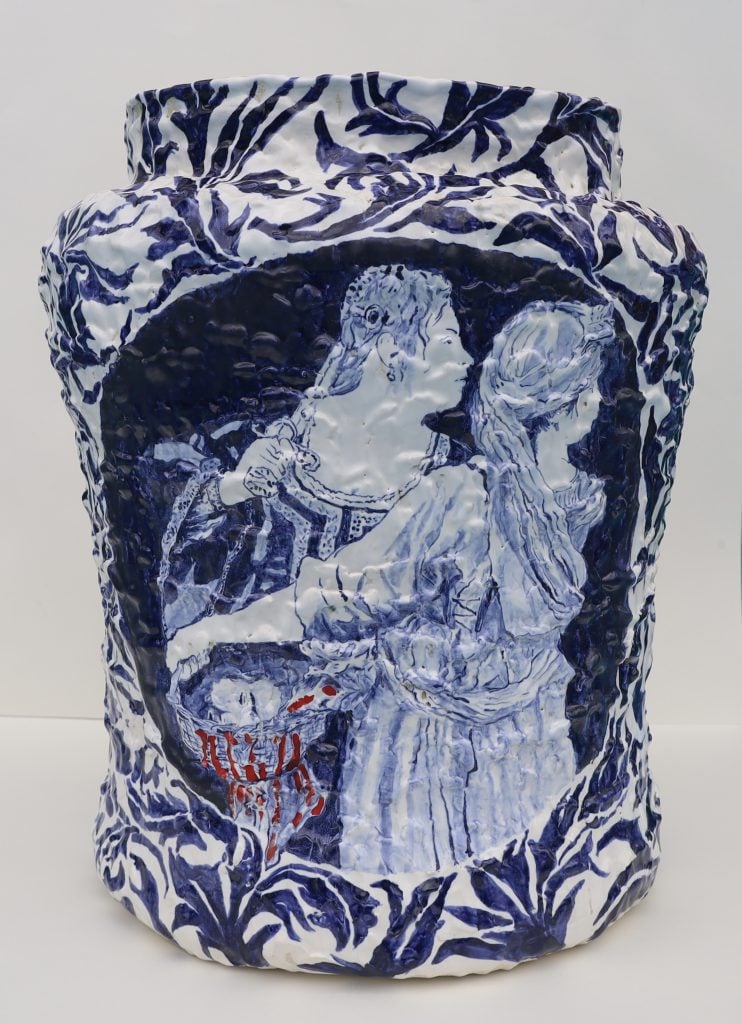
Sachi Moskowitz, Ode to Artemisia (2023). Courtesy of the artist.
When asked what he makes of his granddaughter’s work, Michael Frimkess pauses. “Her lines are incredibly fine. She can do graphics great. She uses the facilities that she inherited for the decoration of the clay. It’s unbelievable,” a kvelling Papa Frimkess says. “She doesn’t need any encouragement. Who knows what phase will be forthcoming.”
Yes, he’s biased, but his endemic allergy to B.S. makes these words all the more sincere. “I’ve never heard you say anything like that before,” Moskowitz says, wiping away tears. “I want to be recognized for my work, but it’s a beautiful thing that this is my life and these are my grandparents,” she adds. “I’m starting to not shy away from that. It’s in the blood.”
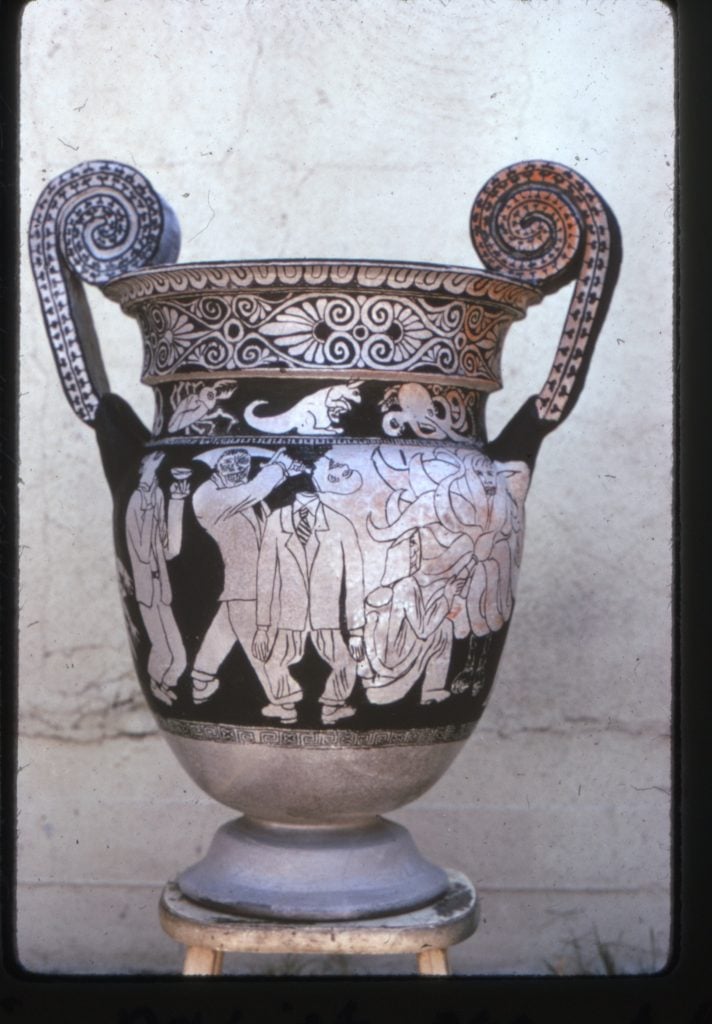
Michael Frimkess, Ecology Krater II (Out Biking with Aunt Samantha) (1976). This work Frimkess’s techniques inspired by the ancient Greeks updated with personal and political imagery. The piece is in the collection of the Smithsonian American Art Museum. Photo by Lou Frimkess.





